 |
 |
 |
| |
HIV Viral Tropism in Vicriviroc VICTOR-E1
Trial: Correlations With Clinical Variables
|
| |
| |
Reported by Jules Levin
4th IAS Conference, July 22-25, 2007, Sydney, Australia
#WEPEA107
Jamal Muhamad Abdul Hamid Suleiman, MD1, Ricardo Sobhie Diaz, MD, PhD2,
Edwin DeJesus3, Jihad Slim, MD4, Elizabeth Lucini5, Lisa Dunkle5, Daniel Alvarez5
1Brazilmed Assistencia Medica e Pesquisa S/C Ltda, Sao Paulo, Brazil; 2Laboratorio de Retrovirologia, Sao
Paulo, Brazil; 3Orlando Immunology Center, Orlando; 4St. Michael's Medical Center-Infectious Diseases,
Newark, NJ, USA; 5Schering-Plough Research Institute, Kenilworth, NJ, USA
Author Summary
A diverse population, including 62.5% from Latin America and 23.7% women, was screened for this Phase 2b trial
This is the first study to examine coreceptor usage in a substantial Latin American population
-- No regional differences in coreceptor usage were observed
-- All patients screened in South Africa were CCR5 positive, but numbers were too small to assess the significance of this finding
Lower CD4+ cell count and male gender were the only parameters associated with an increased risk of D/M- or CXCR4- tropic virus
Viral load, age, gender, HIV-1 subtype, country enrolled and number of resistance mutations were not associated with HIV-1 coreceptor tropism.
ABSTRACT
Objectives: Vicriviroc is an investigational small-molecule CCR5 antagonist that is being evaluated in the Phase 2 VICTOR-E1 study in treatment-experienced patients. Here we explored variables associated with HIV-1 tropism in patients screened for this trial.
Methods: Patients were failing on current stable antiretroviral therapy (ART); triple class experienced; HIV viral load >1,000 copies/mL; >/=1 genotypically documented NRTI and one primary PI mutation; and presence of R5-tropic virus with Trofile™. Patients were to be randomized and treated with vicriviroc 20 mg, 30 mg, or placebo plus a ritonavir-/PI–containing ART regimen.
Results: 451 patients were screened and 116 enrolled at 60 sites in 12 countries between June and November 2006, with 67% of patients screened outside of North America. About half of all screened subjects were from Brazil (46%). Screening mean CD4 count was 219 cells/mm3 (median 184 cells/mm3, range 2-1509 cells/mm3), mean viral load was 4.35 log10 copies/ml, and non-B clade
accounted for 12% of samples. Approximately 35% of screened patients had dual or mixed (D/M)-tropic HIV, 4% had CXCR4 (X4) virus, 45% had R5 virus; the assay failed in 15% of samples. The proportion of R5 virus was similar between patients from North America and rest of the world (52%
and 54%, respectively). D/M- or X4- virus at screening was significantly associated with lower mean CD4 counts than R5 virus (179 vs 228 cells/mm3, p
Conclusions: Prevalence of D/M- and X4-tropic virus in patients screened for this study, including a large Latin American population, was consistent with previous studies from other geographies. DM/X4-tropism is associated with lower CD4 counts.
INTRODUCTION
HIV-1 is able to utilize either the CCR5 coreceptor, CXCR4 coreceptor or both (referred to as dual/mixed or D/M) for cell entry
Since CCR5 and CXCR4 are host coreceptors, it is important to understand coreceptor usage and the potential efficacy of CCR5 antagonists in different populations
The purpose of this analysis was to study determinants of coreceptor usage in subjects screened for an international Phase 2b trial of vicriviroc (VCV)
VCV is an oral, small-molecule CCR5 receptor antagonist that blocks HIV entry into CD4+ T-lymphocytes by blocking engagement of the HIV envelope protein gp120 with the CCR5 coreceptor1
VCV has demonstrated potent and durable antiretroviral activity in CCR5-tropic treatment-experienced patients (see Gulick, abstract 1623)
Methods
STUDY DESIGN
VICTOR E-1 is a multicenter, randomized, placebo-controlled study designed to evaluate the antiviral efficacy of two doses of vicriviroc compared to placebo in combination with a ritonavir- / protease-inhibitor containing optimized antiretroviral therapy regimen in treatmentexperienced CCR5-tropic HIV-1 infected subjects

Entry Criteria
--CCR5-tropic virus (only)
--Triple–class experienced HIV+ patients
-- >/=1 RT resistance mutation
-- >/=1 primary PI resistance mutation
-- HIV-RNA >/=1000 copies/mL on a stable antiretroviral regimen for 36 weeks prior to screening (>/=8 weeks prior to randomization)
-- Acceptable laboratory parameters
Exclusion Criteria
-- Recurrent seizures, or CNS condition or drug use judged to predispose to seizure
-- History of prior malignancy (except resolved Kaposi's sarcoma of the skin or fully resected basal cell carcinoma)
-- Active untreated AIDS-defining opportunistic infections
Statistics
--Logistic regression (Proc Logistic) of SAS V9.1.3 was used for all regression analysis. Univariate logistic regression, multivariate logistic regression, and stepwise logistic regression was completed. For the stepwise model, the significance level to enter, and remain in the model were both set at 0.1
--Variables included in the analysis included screening CD4+ cell count, log10 HIV-RNA, HIV-1 subtype, country, gender, and age
RESULTS
PATIENT DISPOSITION
451 patients screened
-- 26% (116) enrolled
-- Screening mean baseline viral load: 4.35 log10 copies/mL
-- Screening mean CD4+ cell count: 219 cells/mm3 (range 2-1509 cells/mm3)
-- 23.7% female
-- 12% non-clade B
-- 62.5% screened in Central and South America and Caribbean
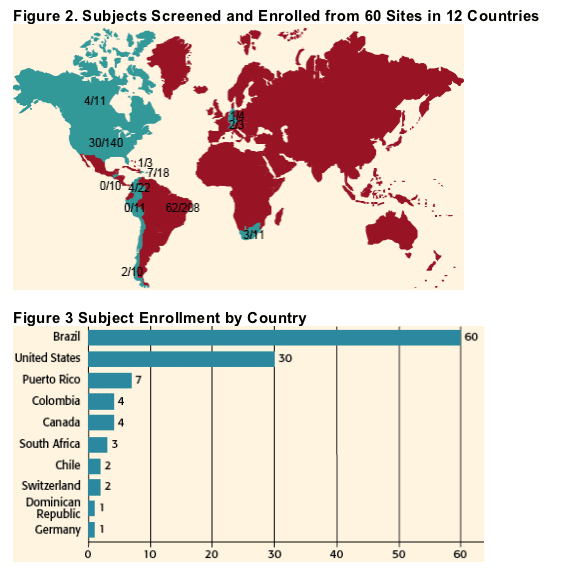
SCREENING FAILURE
Figure 4. Reasons for Screening Failure
The most frequent reasons for inability to determine tropism were viral load <1,000 copies/mL, reduced viral fitness, or compromised sample collection/handling
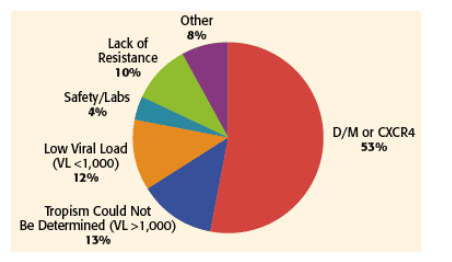
CORRELATION OF HIV-1 CHARACTERISTICS (CD4 Cell Count, Viral Load and Resistance Mutations) WITH HIV-1 TROPISM
CD4 Cell Count
CCR5-tropism was associated with a significantly higher CD4+
cell count (multivariate logistic regression; P =0.029)
There was a trend toward higher incidence of D/M-tropic virus in
lower CD4+ cell count strata (P =NS)
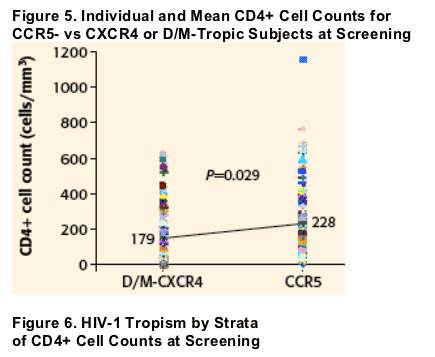
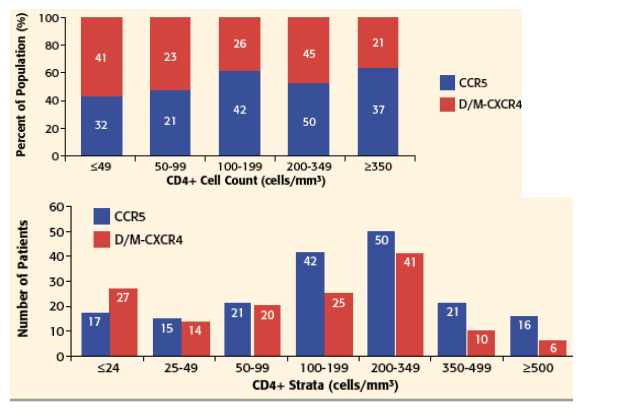
Viral Load
No association was observed between baseline viral load and HIV-1 tropism
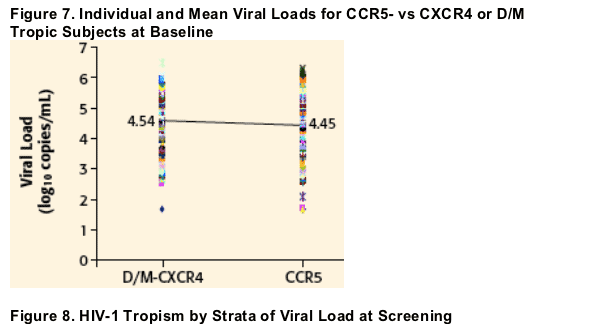
Resistance Mutations
The number of resistance mutations (a) and HIV-1 subtype (b) had no effect on coreceptor usage (P =NS)
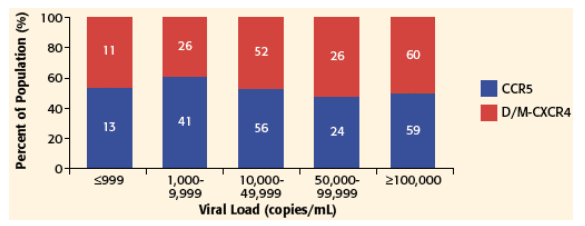
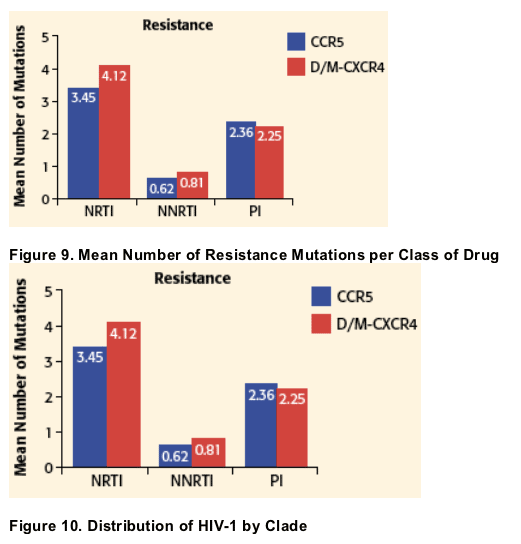
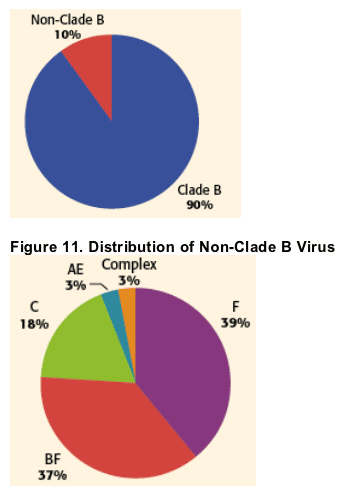
Coreceptor Usage By Region
No difference observed in coreceptor usage by region (P =NS)
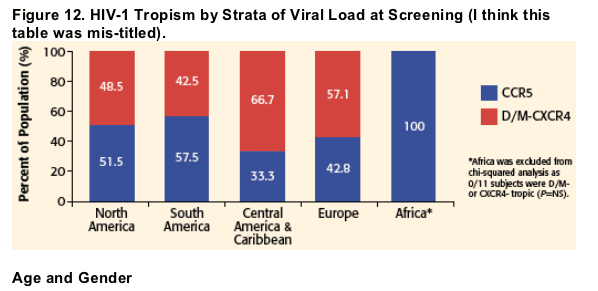
Age had no effect on coreceptor usage
Gender was significantly associated with an increased likelihood of having CCR5- tropic HIV-1 (multivariate logisitic regression; P =0.028) (It doesn't say which gender!!)
Age and gender had no effect on coreceptor usage
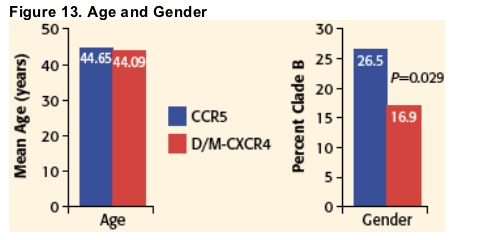
References
1. Strizki JM, Tremblay C, Xu S, et al. Antimicrob Agents Chemother. 2005;49:4911-4919.
|
| |
|
 |
 |
|
|